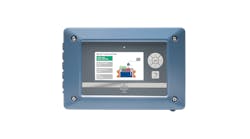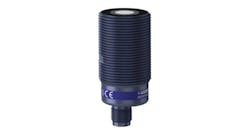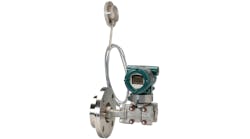PRODUCT ROUNDUP:
Level Instrumentation DevicesSensor Bulks Up
Vibracon point level sensors perform level monitoring for liquids or bulk goods in temperatures up to 300º F. They are immune to foam, turbulence, media changes and build-up, and can be tested inside an empty tank for reduced maintenance requirements. Models are available in intrinsically-safe, explosion-proof, terminal housing and quick-disconnect versions. Options include process connections and the length and material of the sensing fork. Pepperl+Fuchs; 330/486-0002; www.am.pepperl-fuchs.com
Ultrasonic Sensor Sees All
The Type 8175 ultrasonic level transmitter can display a measured value as a level, distance, volume or open channel flow. It has 0.25 % full-scale accuracy over a 132-ft. range, with resolution of 1/8 in. It includes an ultrasonic sensor, transducer, and eight-digit multi-language display protected by a splash-proof plastic NEMA 4 enclosure. Burkert; 800/325-1405; www.burkert-usa.com
Laser Looks Good
The LM200 laser transmitter measures level, distance, and position of dry bulk solids, opaque liquids, and slurries at distances of up to 200 ft., in the presence of dust, vapors, or turbulence. It has a powder-coated aluminum enclosure rated for IP65 or NEMA 4X, and CL II and III, Div 1 and 2, Groups E, F, G dust ignition-proof ratings to FM and CSA. Stainless steel dust tubes prevent dust build-up and protect the optical lens from being coated. K-Tek; 225/673-6100; www.ktekcorp.com
Solid Radar Sensor
The Vegapuls 68 measures level of solid materials, such as flour, sugar, cement, grain, plastic pellets, and aggregates, at ranges up to 230 ft. It is able to see and evaluate echoes in low dielectric conditions, is unaffected by product characteristics such as dust or buildup, and its swivel antenna allows for mounting to match the angle of repose created by fill or empty conditions. Ohmart Vega; www.ohmartvega.com
Ultrasonic Sensor Has a HART
The USonic Series Ultrasonic transmitter measures liquid levels at ranges up to 30 ft. and provides a two-wire 420mA, HART output signal. Made of CPVC, it is suitable for use in environments that are classified hazardous (Class I, Div. 1) or require intrinsically safe or explosion proof installation. The sensor works in temperatures from 40158° F and in process pressures up to 50 psig. Ametek Drexelbrook; 215/674-1234; www.drexelbrook.com
Radar Love
Pulsar pulse burst radar transmitters measure liquid level. The lightweight device is loop-powered with HART digital communications. It has horn and rod antennas, a quick connect coupling to remove or install the transmitter without removing the antenna from the process, and full international safety and telecommunications approvals. Magnetrol; 630/969-4000 x343; www.magnetrol.com
Strick It to Me
The 7330 Series Magnetostrictive Level System measures liquid level and diagnoses problems. The normal 420mA output indicates the position of the float within the span. If the level is outside the set span, the output is either 3.9 mA or 20.1 mA. If the float moves into the null or dead zones or there is a sensing failure, then the output is 3.8 mA. Ametek A&PT; 248/435-7540; www.ametek.com
Sounds Hazardous
IRU-2000/3000 ultrasonic sensors are CSA approved for operation in Class I Division 2, Group A, B, C and D hazardous locations. They have a detection range from 135 ft., and are not affected by the color, translucency, dielectric constant, specific gravity or viscosity of the target. Temperature compensation automatically adjusts for ambient temperature changes, and a programmable filter accounts for liquid motion or tank irregularities. Scientific Technologies; 888/349-7098; www.stiapg.com
AC/DC Sensor
The QT50U Series universal voltage ultrasonic sensor measures level at distances up to 8 m and accommodates 48250 VAC or 24250 VDC, making it suitable for use on equipment where only AC power is present. Models are available for fill level control logic or standard window limit applications. In Retro-sonic mode, it detects any object that passes between the sensor and its setpoint. Banner Engineering; www.bannerengineering.com
Multivariable Transmitter Checks Density
The IMV31 density-compensated level transmitter uses differential pressure, pressure, and temperature measurements to compensate for liquid and vapor density changes. It transmits a 420 mA output signal proportional to level with HART digital communications. The sensor is suitable for both open (vented) and closed (pressurized) tanks. Foxboro; 508/549-6321; www.foxboro.com
Free Space Radar
The Micropilot M FMR250 radar level gauge measures plastic pellets, corn, soybeans, cement and fly ash under harsh process conditions, dust, vapors and changing product properties. Maximum measuring range is 230 ft. The two-wire, loop powered level gauge installs easily into existing manholes and process connections reducing start up time and costs. Endress+Hauser; 888/end-ress; www.us.endress.com
Level Switch
The FlexSwitch FLT93 flow/level/temperature switch is ATEX approved for use in potentially explosive environments classified as Ex II 2G Eexd IIC T4. It works as a point level and interface sensor in liquid, gas or foam. Applications include sump level detection, high/low level alarm /control, interface control in separation vessels, foam and sediment interface control, and agitation detection. FCI; 800/863-8703; www.fluidcomponents.com
Level Gauge Goes the Distance
Optiwave 7300 C Radar Level Meter measures distance, level and volume of liquids, pastes and solids at a maximum range of 131 ft. It works in the presence of struts, inlets, ladders, agitated surfaces and foam. The device is available with four different types of screen displays: alphanumeric, alphanumeric with tank illustration, alphanumeric with bar graph and signal screen. Krohne; 978/535-6060; www.krohne.com
Snap-On Level Sensor
The TLS 100 capacitive level sensor detects the presence or absence of liquids at a chosen level within plastic tubes, rubber hoses, and small glass or plastic pipes. The sensor is snapped onto the tube at the level to be monitored. The aluminum mounting clips serve as the sensing electrodes, allowing measurement to occur across a wide area. E-T-A; 847/827-7600; www.e-t-a.com
Capacitive Sensor Replaces Switches
The Leveltrak sensor can replace mechanical float switches. Models are available with two or four switching outputs, so one unit can replace up to four binary switches. The sensor determines level by measuring the point of dielectric contrast that occurs at the level height. A software algorithm scans 16 sensing fields along the length of its probe to determine the point at which the change in dielectric occurs. Ifm Efector; 800/441-8246; www.ifmefector.com
Displacer Wafer Fits Anywhere
Types DL3 and L3 wafer-style displacer level gauges allow direct top mounting onto a vessel, or mounting between flanges of user-supplied fabricated cages. Available in 3 or 4-in. sizes, the wafer body fits Class 150 thru 600 raised-face flange connections. The DL3 produces a 420mA analog output signal and is HART compliant. The L3 produces a pneumatic output signal. Emerson/Fisher Controls; www.emersonprocess.com
Capacitive Sensor Suits Semiconductors
Metal is not allowed inside the process area of a typical semiconductor facility, so the QF5.5 capacitive sensor has a cover and an all-plastic (polypropylene) housing that seals the metal potentiometer from the process area. There is no exposed metal on the sensor, making it suitable for semiconductor liquid level applications. Turck; 800/544-7769; www.turck.com
Level Sensor Talks Via Profibus PA
The Sitrans LR 200 radar level transmitter conforms to the Profibus PA Profile version 3, Class B standard. It can be programmed with Siemens Simatic Process Device Manager (PDM) for configuration, parameter setting, record keeping and diagnostics, including trending and echo profiles. The radar transmitter provides level measurement in liquid bulk storage or simple process vessels. Siemens Energy & Automation; 215/ 646-7400; www.sea.siemens.com
Level Monitor Diagnoses Itself
The TN PNM Level System for fly ash hoppers measures level, identifies problems such as wall buildup or equipment failure, and sends an alarm signal. It can monitor up to 64 fly ash hoppers and displays the operating status of each at a single, centralized indicator panel. ThermoElectron; www.thermoelectron.com
Horny Level Sensor
Pegasus radar level transmitter uses frequency-modulated continuous wave (FMCW) technology to measure level at ranges up to 100 ft. It is available with rod and horn antennae in intrinsically-safe and explosion-proof models. The rod antenna version comes with a standard 1.5-in. mounting thread. A flanged mounting is also available. The horn antennae are available with 100 mm dia. for minimum protrusion into the vessel. Solartron Mobrey; 01753 756600; www.solartronmobrey.com
Be Still, My Pipe
The RTG 3950 radar level gauge mounts on existing still-pipes. Typical applications are crude oil tanks with floating roofs and gasoline/product tanks with or without inner floating roofs. Measurement is made with custody transfer accuracy, even when the pipe is old, rusty and covered with deposits. Emerson Saab; +46/31/337-0226; www.emersonprocess.com
Level Sensors Talk over Modbus
EchOsonix line-powered level transmitters now use Modbus communications, so up to 128 transmitters can communicate on one shielded, twisted pair cable. All the units can be polled in less than two seconds. SOR; 262/784-2088; www.sorinc.com
Self-Sealing Float Switch
This level control switch can be installed without entering the tank. Just insert the switch from the outside and tighten the nut. The compression grommet forms a seal on the inside of the tank wall. It can be used on tanks with a wall thickness of 5/32 in. or less. Switches come in polypropylene or nylon, with nitrile or silicone grommets. Cole-Parmer; 800-323-4340; www.coleparmer.com
Underground Sensor
Model USTD II liquid level magnetostrictive sensor is suitable for leak detection and inventory monitoring of underground storage tanks. It can sense inventory level, interface level and temperature, and requires only a single opening in the tank. Applications include upgrades of existing tanks using older mechanical, capacitance or radar technologies. MTS Sensors; 919/677-2332; www.mts.com
Foundation Radar
The 5600 Series non-contact radar level measurement transmitter for process applications on liquids and slurries has HART, Foundation fieldbus, and analog outputs. It is available with a full range of antennae, has software that discriminates between false echo sources and true surface echoes, and can use information provided by the operator about stirrers or other obstructions. It can drive remote displays and up to six externally mounted temperature sensors. Emerson/Rosemount; 952/949-5165; www.emersonprocess.com
Flush-Mount Transmitter
The loop-powered King Gage ES2i transmitter for hydrostatic tank gauging is suitable for sanitary applications. Sensor is isolated using seals while maintaining atmospheric reference. Non-repeatability for process control monitoring is less than 0.02% FS. Options include remote zero and terminal junction. King Engineering; 800/242-8871; www.king-gage.com

Leaders relevant to this article:




